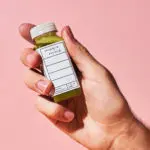
Nature has long been a source of valuable ingredients with transformative properties, and seaweed stands out as a remarkable resource. They are a valuable natural resource for cosmetics, especially in the form of seaweed extracts.
The industry and scientific community have developed sophisticated extraction processes such as solvent extraction, but how do they differ from supercritical fluid extraction, enzyme extraction and more? How are they being used in context to seaweed extracts? What are their benefits? Find the answers to all of these questions and more, while gaining valuable insights into the transformative properties and undeniable advantages that seaweed extracts offer.
Which extraction processes are being used in cosmetics to generate seaweed extracts?
Cosmetics employ a range of extraction processes and types of extract to harness the beneficial qualities of seaweed. These methods and extracts are carefully chosen to ensure optimal efficacy and desirable results.
Solvent extraction
Solvent extraction is utilized to extract compounds from plant or algae materials that are not easily accessible through other methods. Solvents like ethanol or hexane are used to dissolve the desired components. The solvent is then evaporated, leaving behind a concentrated extract. This process is commonly employed to obtain plant extracts such as chamomile, green tea, and ginseng but also algae. Examples of algae extracts produced using this technique are Porphyra umbilicalis alcohol extracts and Palmaria palmata alcohol extracts. These extracts are valued for their antioxidant, soothing, and rejuvenating properties in cosmetic applications.
Supercritical fluid extraction
Supercritical fluid extraction is a method that uses supercritical carbon dioxide as a solvent to extract algae or plant compounds. This process is particularly useful for obtaining delicate or heat-sensitive ingredients. It is commonly used to extract natural fragrances, flavors, and bioactive compounds. Supercritical fluid extraction is employed to obtain extracts like vanilla, rose, and ginger, which are utilized in perfumes, skincare, and haircare products but also algae. One prominent example for this is Astaxanthin extracted from Haematococcus pluvialis.
Enzyme extraction
Enzyme extraction involves utilizing specific enzymes to break down plant material and release desired compounds. This method is often employed to extract active ingredients from fruits and botanicals as well as some algae even though more infrequently than other types of extraction. Enzyme extraction helps obtain extracts rich in vitamins, antioxidants, and enzymes, which provide nourishing and rejuvenating properties for the skin. Fruit extracts like blueberry, strawberry, and citrus extracts are commonly obtained through this process.
Maceration and infusion
Other extraction processes used in cosmetics include maceration, infusion, and fermentation. Maceration involves soaking plant material in a carrier oil or solvent to extract the desired components. This is one of the most common techniques of extraction employed to produce seaweed extracts. The resulting products are water-glycerin when glycerin is added, water extract, or oil based, which are available for a wide range of macroalgae.
Fermentation
Fermentation is being used to produce bioactive compounds. These processes are employed to obtain various botanical and algae extracts used in cosmetics. A well known example for this, is the extraction of DHA from microalgae such as Schizochytrium sp. using a fermentation process to increase the DHA yield in the final extraction.
The cosmetics industry continuously explores and innovates with extraction processes and types of extract to discover new ingredients and create effective formulations. One such example is mechanical cell rupture, such as the freezing-thawing method, which can be employed to extract Phycocyanin pigment from Spirulina platensis in a significant amount, using distilled water as the solvent.
By carefully selecting the appropriate extraction method and type of extract, cosmetic manufacturers can harness the power of nature and deliver high-quality products that meet the diverse needs of consumers.
Why are extracts good in skincare products?
Extracts are beneficial for the skin due to their rich composition of natural compounds that offer a wide range of advantages. These compounds possess properties that promote skin health, nourishment, and rejuvenation. Let’s explore why extracts are considered beneficial for the skin as moisturizing, anti-aging and toning agents.
Antioxidative properties
Firstly, extracts are often rich in vitamins, minerals, and antioxidants. These components play a vital role in supporting the skin’s overall health and well-being. Vitamins like A, C, and E, which are all present in algae such as Dunaliella salina, and are known for their antioxidant properties, which help protect the skin from damage caused by free radicals and environmental factors. Antioxidants also aid in reducing inflammation and improving the skin’s natural defense mechanisms, resulting in a healthier and more radiant complexion.
Calming properties
Secondly, extracts contain bioactive compounds that offer specific benefits to the skin. For instance, plant and seaweed extracts, for example Laminaria digitata glycerin or oil extracts possess soothing and calming properties, making them ideal for sensitive or irritated skin. These extracts help alleviate redness, inflammation, and discomfort, promoting a more balanced and comfortable skin condition.
Moisturizing properties
Furthermore, extracts often have hydrating and moisturizing properties. Natural oil extracts are renowned for their ability to replenish the skin’s moisture barrier, preventing dryness and promoting softness and suppleness. These extracts help restore moisture balance and prevent water loss, keeping the skin adequately hydrated and nourished. One example for this is Chondrus crispus in glycerin extract form.
Anti-aging properties
Extracts also offer various anti-aging benefits. Many plant- and seaweed-based extracts contain compounds that support collagen production and promote skin firmness and elasticity, one notable example for this is Astaxanthin oleoresin extracted from Haematococcus pluvialis using supercritical extraction processes. Marine extracts derived from algae and seaweed, for example, are rich in nutrients and minerals that help combat signs of aging, including fine lines and wrinkles. These extracts contribute to a more youthful and revitalized appearance.
Anti-inflammatory properties
Moreover, extracts can possess antimicrobial and anti-inflammatory properties. Certain extracts exhibit antimicrobial effects that help control acne-causing bacteria and prevent breakouts, one example for this are derived extracts from Ulva lactuca. These extracts also assist in reducing inflammation, soothing redness, and promoting a clearer and healthier complexion.
Brightening properties
Additionally, extracts often provide brightening and complexion-evening effects. Some plant and seaweed extracts contain natural acids and enzymes that help gently exfoliate the skin, promoting a brighter and more even skin tone, most notably brown macroalgae such as Fucus vesiculosus and Undaria pinnatifida. These extracts assist in reducing the appearance of dark spots, hyperpigmentation, and dullness, revealing a more radiant complexion.
Overall, extracts offer a myriad of benefits for the skin. From providing essential nutrients and antioxidants to supporting hydration, soothing irritation, and combating signs of aging, these natural compounds contribute to overall skin health and beauty. Incorporating extracts into skincare products helps to harness their specific properties and deliver targeted solutions for various skin concerns, resulting in a healthier, more vibrant, and rejuvenated complexion.
Are seaweed extracts good for the skin?
Seaweed extracts are indeed beneficial for the skin and have gained popularity in skincare products for several reasons. Seaweed is a marine organism that is rich in various nutrients, vitamins, minerals, and antioxidants, which contribute to its positive effects on the skin.
One of the key advantages of seaweed extracts is its hydrating properties. It helps to moisturize the skin and improve its overall hydration levels. By retaining moisture and preventing dryness, seaweed extract such as water extracts from Saccharina latissima can enhance the skin’s elasticity, leaving it looking smoother and more supple.
Seaweed extracts are also known for their nourishing effects on the skin. They contain essential nutrients like vitamins (such as vitamin A, vitamin C, and vitamin E, of which one example are extracts from Undaria pinnatifida), minerals (such as magnesium, calcium, and zinc), and amino acids. These nutrients provide nourishment to the skin, supporting its health and vitality.
Additionally, seaweed extracts offer anti-aging benefits. They contain antioxidants, including polyphenols and phlorotannins, which help protect the skin from free radicals and oxidative stress. Free radicals can lead to premature aging by damaging collagen and elastin fibers, resulting in the formation of wrinkles and sagging skin. The antioxidants in seaweed extracts, such as those derived from Undaria pinnatifida, can help neutralize these free radicals, reducing the signs of aging and promoting a more youthful appearance.
Many seaweed extracts are known for their soothing properties, making them suitable for individuals with sensitive or irritated skin. Among them are Laminaria digitata, Ulva lactuca and Fucus vesiculosus extracts, but there are many more. They can help calm inflammation, alleviate redness, and soothe irritated skin conditions, providing relief and promoting a healthier complexion.
Certain types of seaweed extracts, such as brown algae extracts derived from Fucus vesiculosus and Undaria pinnatifida, have been found to have brightening and clarifying effects on the skin. They can help even out skin tone, reduce the appearance of dark spots or pigmentation, and promote a more radiant complexion.
Overall, seaweed extracts are valuable ingredients in skincare due to their hydrating, nourishing, anti-aging, soothing, brightening, and detoxifying properties, making them beneficial additions to various skincare products.
What are the main benefits of using extracts over whole algae or plant matter in cosmetics products?
Using extracts in cosmetics products offers several advantages over using whole plant matter.
Starting with the fact that extracts provide a concentrated form of the desired active compounds present in the plant. The extraction process allows for the isolation and concentration of specific beneficial components, such as vitamins, antioxidants, essential oils, or polysaccharides, which are responsible for the algae’s desired effects on the skin or hair. By using extracts, cosmetic manufacturers can ensure a consistent and potent dose of these active compounds in their products, resulting in more predictable and reliable outcomes.
In addition, extracts often have improved stability compared to whole algae matter. Some active compounds in plants can be sensitive to environmental factors such as light, heat, and oxidation, leading to a loss of efficacy over time. By extracting and isolating these compounds, manufacturers can enhance their stability and prolong their shelf life. This allows consumers to enjoy the benefits of the plant-derived ingredients for a longer period.
It should be added that extracts offer greater versatility in formulation. Cosmetic products need to have specific characteristics, such as texture, aroma, and consistency, to provide a pleasant and desirable user experience. Whole plant matter may introduce unwanted elements, such as fibers, residues, or inconsistent texture, that could affect the product’s overall quality. Extracts, on the other hand, can be more easily incorporated into formulations without compromising the desired product attributes. They offer better control over the final texture, color, and scent of the product.
Furthermore, using extracts allows for targeted application and customization. Different parts of a plant may contain varying concentrations of active compounds. By selectively extracting specific parts or using specific extraction methods, cosmetic manufacturers can tailor the extract to focus on the desired properties. For example, using the flowers of a plant may yield a floral extract with a pleasant fragrance, while using the leaves may produce an extract rich in antioxidants. This customization enables cosmetic brands to create products that address specific skincare or haircare concerns effectively.
Extracts from algae offer several benefits over using the whole matter of algae when it comes to easier bio-accessibility of the compounds for the human body. Algae extracts are derived through a process that isolates specific beneficial compounds, such as antioxidants, vitamins, and minerals, from the algae. By extracting these compounds, they can be concentrated into a more potent form, making them easier for the body to absorb and utilize. This increased bio-accessibility allows for a more targeted and efficient delivery of the beneficial components present in algae, maximizing their potential health and skincare benefits.
Lastly, using extracts may minimize the risk of potential allergic reactions or sensitivities. Some individuals may be sensitive to certain plant compounds, such as essential oils or pollen, which can be present in whole plant matter. By using extracts, manufacturers can carefully control the composition of the product, reducing the likelihood of adverse reactions and making it suitable for a broader range of consumers.
Seaweed extracts – Promising natural resources
In conclusion, the power of seaweed extracts in cosmetics reveals a world of possibilities and benefits. From its rich nutrient profile to its impressive hydration and anti-aging properties, seaweed has firmly established itself as a force to be reckoned with in the realm of skincare. Through various extraction methods, the valuable components of seaweed and microalgae are harnessed and incorporated into innovative cosmetic formulations, offering individuals a chance to experience the remarkable effects firsthand.
As you venture forth in your skincare journey, consider incorporating seaweed extracts into your products and witness the transformative potential they hold. Let us embrace the natural wonders of the ocean and unlock the true power of seaweed for radiant, healthier-looking skin.
We would be happy to help you make your next product possible.
Find out more about our seaweed extracts.
Sources:
https://www.ncbi.nlm.nih.gov/pmc/articles/PMC7398001/
https://www.ncbi.nlm.nih.gov/pmc/articles/PMC5905184/
https://www.ncbi.nlm.nih.gov/pmc/articles/PMC7344841/
https://jcadonline.com/macroalgae-extracts-in-cosmeceuticals/
https://dopeskin.co/blogs/skincare/what-are-extracts-in-skin-care
https://www.ncbi.nlm.nih.gov/pmc/articles/PMC9000874/
https://iopscience.iop.org/article/10.1088/1757-899X/633/1/012025







Comments by Pit Wagner